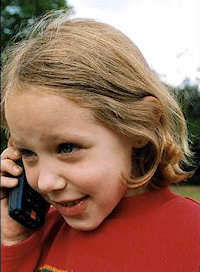 |
 |
|
 |
 |
About Us | Contact |
|
|
11/01/2010 - Young children's use of mobile phones soars in the UKFor many children, it seems that their own mobile phone is the latest "must-have" item. The average age for youngsters to get a mobile is eight - and the average kids' bill is £10.50 a month. Many parents are ignoring current UK Chief Medical Officers' (CMO) and Department of Health (DH) advice that young children should only use a mobile phone if essential and are buying their young children mobile phones. It is estimated that over 50% of 5 to 7 year-olds now have been given their own handset and this rises to about 75% by age 10.
It is not yet known if the long-term use of mobile phones is safe. Despite frequent re-assurances, some very concerning scientific studies are continuing to be published. A 2009 Swedish study[Hardell 2009] by Lennart Hardell and Michael Carlberg found that first use of a mobile phone before the age of 20 had increased a victim's chance of developing a brain tumour by 5-fold. They also found that the overall risk across all users increased significantly with time. Analysing 663 astrocytomas/gliomas (the most common types of brain tumour) they found a 2.5 to 5-fold increased incidence in people with more than ten years of mobile phone or cordless phone use. If their findings prove generally true, we have to ask if their will be an epidemic of brain cancer in another ten years time. Parents have a moral responsibility to protect their children - how will they feel if their child later develops a brain tumour because they bought them a mobile phone when they were young? How will their children think about them then? Was the street-cred buzz, the playground chats and texts really worth the risk?
"We feel safer if we know we can contact each other" many say. Sadly, that did not prevent the tragic incident involving the two ten year-old girls Holly Wells and Jessica Chapman who both had their mobile phones with them. One phone was found smashed and lying in a field. There may be case for secondary-age school-children having a handset that they use when really necessary, but surely not 5 to 10 year-olds? The current Deapartment of Health Mobile Phones leaflet states that the UK CMOs strongly advise that where children and young people do use mobile phones, they should be encouraged to (a) use mobile phones for essential purposes only, and (b) keep all calls short - as talking for long periods prolongs exposure and should be discouraged. The UK CMOs recommend that if parents want to avoid their children being subject to any possible risk that might be identified in the future, the way to do so is to exercise their choice not to let their children use mobile phones.
That DH leaflet is meant to be on display in all mobile phone shops. Most can't even find a copy for you if you go in and ask for it. The Daily Mail covered the DH advice issue in September 2009. An investigation by Adrian Butler in the Mirror Newspaper just before Christmas found shops knowingly selling pay-as-you-go mobiles to children of 10 and 11 years of age. In five towns around the UK, they managed to buy phones in eleven shops, and were only turned down in three. Branches of stores which sold them phones included Tesco, Carphone-Warehouse, Phones 4U and Currys Digital. This suggests that their management is not listening to Department of Health advice. There is repeated evidence that short-term use can slightly stimulate brain activity and speed up certain tasks. However, according to a recent study carried out in Australia[Abramson 2009] with children aged 11-14 doing a series of computer tests, the higher speed resulted in less accuracy. One possibility is that the built-in speed writing tools for mobile SMS messaging is training children to respond quickly and impulsively and with less thought. Another is that the electromagnetic stimulation is somehow impairing the quality of their thought processing. The long awaited and much delayed Interphone study does not include under 30 years of age, so that will not help. The non-inclusion of under 30 year olds is likely to result in an underestimation of risk. Research has shown that children's brains (due to skull formation through the childhood years) absorb a greater proportion of the radiation emitted by a mobile phone[Ghandi 1996, Ghandi 2002, Christ 2005, de Salles 2006, Wiart 2008]. They are also likely to be at a greater risk due to their higher rate of cell division (than adults). It is generally accepted that teenagers and young adults are the primary users of mobile phones. External Links
Links to other UK sites discussing this issue» the Cavi Society References1. P
Hardell L, Carlberg M, (July 2009) Mobile phones, cordless phones and the risk for brain tumours, Int J Oncol. 2009 Jul;35(1):5-17. [View Author's abstract conclusions] [View
on Pubmed]
2. P
Abramson MJ et al, (July 2009) Mobile telephone use is associated with changes in cognitive function in young adolescents, Bioelectromagnetics. 2009 Jul 30. [Epub ahead of print] [View Author's abstract conclusions] [View
on Pubmed]
3. -
Ghandi O, Kang G, (1996) Effect of the head size on SAR for mobile telephones at 835 and 1900MHz, Bioelectromagnetics Society 23rd Annual Meeting. St. Paul, Minnesota, USA, June 10-14, 2001, p. 52 [View Author's abstract conclusions]
4. -
Ghandi O, Kang G, (May 2002) Some present problems and a proposed experimental phantom for SAR compliance testing of cellular telephones at
835 and 1900 MHz, Phys. Med. Biol. 47 1501 18 [View Author's abstract conclusions] [View
on Pubmed]
5. -
Christ A, Kuster N, (2005) Differences in RF energy absorption in the heads of adults and children, Bioelectromagnetics. 2005;Suppl 7:S31-44 [View Author's abstract conclusions] [View
on Pubmed]
6. -
de Salles AA et al, (2006) Electromagnetic absorption in the head of adults and children due to mobile phone operation close to the head, Electromagn Biol Med. 2006;25(4):349-60 [View Author's abstract conclusions] [View
on Pubmed]
7. -
Wiart J et al, (July 2008) Analysis of RF exposure in the head tissues of children and adults, Phys Med Biol. 2008 Jul 7;53(13):3681-95 [View Author's abstract conclusions] [View
on Pubmed]
Also in the newsCourt rules that man's tumour is related to phone use in ItalyToday, for the first time, a Labour Tribunal recognized the occupational origin of the illness of a man who for ten years was a company executive in Brescia. He worked for long hours using a mobile and a cordless phone. The man, Innocenzo Marcolini, 57, had a benign tumor on the trigeminal nerve. Surgery saved him but the consequences on his quality of life are terrible. He is partially compensated by this victory against INAIL (the Italian Labour Insurance) that recognizes the 80% of disability caused by his occupation. This is the first time a judge has recognized the causal link and the subsequent declaration of disability due to occupational exposure to EMFs. The information on this court case comes from the biologist Angelo Levis, Professor of Mutagenesis at the University of Padua, an authority on the effects of EMFs on human health. He and Joseph Grasso, a neurosurgeon from Brescia, were called as expert witnesses for the plaintiff. He recounts that he was contacted three years ago by two people, one from Brescia and one from Cremona, who had very similar jobs to that of Mr Innocenzo Marcolini. They worked in customer services, and made extensive use of cordless and mobile phones. While writing with the right hand, they kept the telephone to the left ear. The man from Cremona developed a malignant parotid tumour, while the man from Brescia had a benign tumour involving the trigeminal ganglion. In both cases the tumour developed on the left side of the head. There is also further background reading for those interested Police officers sue force over 'radio injuries'Police officers are preparing to sue their own force over a series of illnesses they claim were caused by the radio system they use while out on patrol. The Lancashire Constabulary was the first in Britain to try out the Airwave network, designed specifically to hive longer range and more capcaity to the emergency services and the military. Nine years after its introduction scores of officers are claiming that radiation emissions from the system have caused them to suffer such ailments as nausea, headaches, stomach pains and skin rashes. The local branch of the Police Federation has logged 176 individual complaints, and now senior officials at the police authority are seeking legal advice on how to deal with them. Read original story in the Telegraph. New Scientist runs a misinformation article by Mike RepacholiEntitled "Cellphones and cancer: Interphone can't end the debate", the New Scientist has run an article by ex-head of the World Health Organisation EMF project explaining why the Interphone project work is so flawed that its findings can't be considered reliable. Starting by strongly attacking the study project's protocol (which as we've previously covered, has a wide range of flaws), the article then starts firing out complete nonsense on the mechanistic aspects of RF electromagnetic fields. It is widely acknowledged that "RF fields do not have enough energy to break chemical bonds in DNA", but the conclusion that the author draws that "[therefore] they simply cannot cause the mutations required to initiate cancer" is simply a scientific fallacy. The National Grid's EMF info site has run a cautious but very solid article explaining precisely this, and alluding to other mechanisms by which it could be theoretically feasible for RF to damage DNA indirectly. One of these mechanisms highlighted is the creation of free radicals, something that has already been associated in the peer reviewed literature with exposure to RF EMFs [Friedman 2007, Yao May 2008(1), Yao May 2008(2)] This page has links to content that requires a .pdf reader such as |




